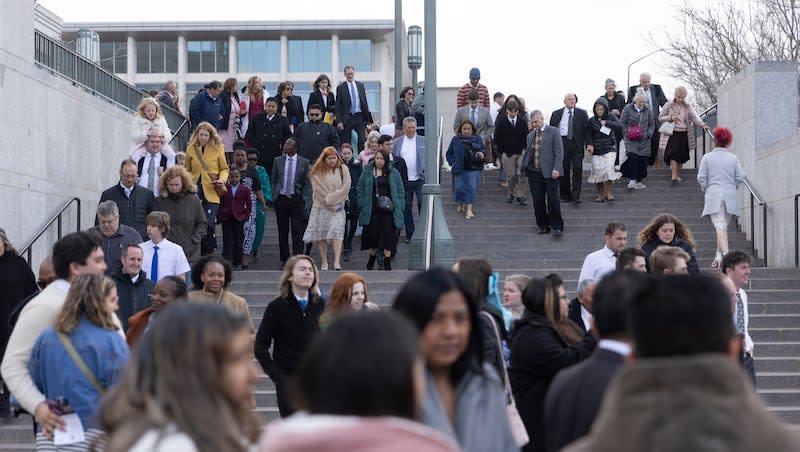The New York Post gave a tutorial on how not to write about Latter-day Saints

Do Latter-day Saints look alike? That’s the subject of a recent article from the New York Post.
The Post published the article Monday with the headline, “I’m an ex-Mormon — here’s why members of my former church look alike.” The piece cobbles together quotes from a one-minute YouTube short video and a couple of research papers to advance the idea Latter-day Saints look alike.
The Church of Jesus Christ of Latter-day Saints, however, has more than 17.25 million members around the world. With 6.8 million church members in the United States, a majority of church members live outside with recent growth in places like Africa, the Philippines, Central and South America and the Pacific Islands, according to statistics from the Church Almanac.
The Post article, however, suggests Latter-day Saints have a small gene pool relegated mostly to Utah and the Mountain West. While it’s true many members of the church live in Utah, and Latter-day Saints tend to marry within the faith, as church members pointed out online it’s misleading to claim that this leads to members looking alike when the church is comprised of people from roughly 175 countries.
Is it the yellow, sunken, cadaverous visage, or the thick, protuberant lips? https://t.co/fFUzLcQubY
— McKay Coppins (@mckaycoppins) April 17, 2024
The Post story also suggested Utah mothers are prone to undergo plastic surgery — what the story calls “the Mommy Makeover” — due to local pressure, citing a 2013 study. The study, however, surveyed 100 Latter-day Saint women in Utah and only four of them said they had cosmetic surgery — a number lower than the national average. Additionally, survey data from the “The Next Mormons” study in 2016 suggests Latter-day Saint women in Utah report lower rates of cosmetic surgery than the national average.
The Post story also said that the Church of Jesus Christ gives “beauty tutorials” and linked to an article called “Beauty Tips” from the 2001 issue of the New Era, a youth magazine which has since been renamed by the church. The New Era article doesn’t offer a guide to beauty tips in any traditional sense, but is instead a fictional short story about a girl who battles to overcome negative thoughts about her own self-image. After reading inspirational scriptural passages with her mom, the character in the story discovers that beauty transcends appearance and comes from a deeper source of faith and self-worth.
Daryl Austin, contributing writer for USA Today and NBC News, tweeted that he thought the Post article was interesting, but “characterizing a 2001 LDS youth magazine fictional story that talks about personality and intelligence being more important than outward appearance as ‘The Latter-day Saints church website even offers beauty tutorials’ is among the most sloppy and misleading reporting I’ve ever encountered.”
I’m LDS and find some points in this article interesting. But @AMitchReporting characterizing a 2001 LDS youth magazine fictional story that talks about personality and intelligence being more important than outward appearance as “The Latter-day Saints church website even offers…
— Daryl Austin (@darylaustinUT) April 17, 2024
The Post article does not appear to quote any actively participating members of the Church of Jesus Christ, nor does the article cite any response from the church itself. There’s no perspectives offered providing context around phrases in the article such as “the Mormon vibe, which is often super hyper-friendly, almost too friendly” or “I think that Mormon culture is very copycat.”
Thomas Stevenson, a writer with The Post Millennial and a Latter-day Saint, said he sent an email to the author of the Post article pointing out various issues but did not hear back as of Wednesday afternoon, and no corrections to the article had been made by the New York Post.
Some Latter-day Saints reacted positively to the article online. One X user who goes by “Black Blessed LDS” online called the article a win because it referenced a study that showed a connection between spirituality and healthy habits.
“A 2010 research paper found that non-Mormons can properly identify Mormons 60% of the time, thanks mostly to a common skin texture shared among members. People make inferences about group membership based on how healthy someone looks, and some see spirituality in that,” the… https://t.co/OkTnXecCUo
— B-LDS (@BlackBlessedLDS) April 17, 2024
Recent survey data suggest U.S. adults hold a more unfavorable opinion of Latter-day Saints compared to other faith groups and also that many Americans don’t know much about Latter-day Saints. According to the same study, Latter-day Saints had among the highest opinion of all other faith groups in the survey.
U.S. and global media consumers are hungry for better portrayals of religious people in media, according to The Global Faith and News Media Study from HarrisX and the Faith and Media Initiative, which surveyed 9,489 people and found that 61% of respondents think the media perpetuates faith-based stereotypes.

